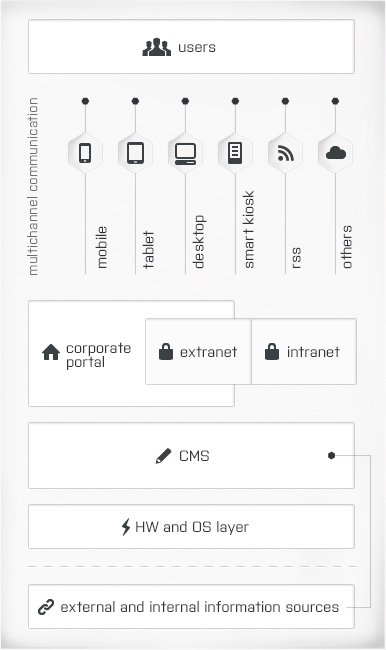
What is a corporate web portal and what are its goals?
The definitions of a web portal may vary, depending on the source, but all have certain aspects in common.
Also, you should not miss the previous part of the article series about web integration – Principles and topology of web integration. It is a must-read!
The key features of a corporate web portal are:
- Central access to otherwise decentralised, retained information, i.e. integration of internal and external data sources,
- The option to personalise content for target user groups (e.g. clients, suppliers and employees), at a specified level of security,
- Active user interaction,
- A single method of user sign-in and records,
- A powerful search core, capable of including all information sources,
- A strong operating platform enabling the full use and development of the portal, which provides the tools for simple, decentralised management,
- Support for various client platforms (multichannel communication) and the ability to exchange data in a structured format,
- The right type of information architecture, which supports the goals of the portal and enables large amounts of information to be presented in a clearly laid out and user-friendly way.
Therefore, in practice, a corporate website providing information taken from internal or external systems of the operator to target groups of users, based on their identity, can be regarded as a portal solution. The websites are operated on a platform, which eliminates dependence on just one supplier. In addition, the platform is sufficiently efficient and robust to facilitate further smooth development of the portal and meet ever-increasing demands for efficiency and new functionality.
You can find an example of a corporate web portal here: https://www.microsoft.com
The websites meet the basic criteria: strong integration of the internal systems of the client and that on different platforms: centralisation of access to information; inclusion of a client zone, with content personalisation and central identity management; management of personal settings as part of products offered; CMS, providing opportunities for further development.
You can find an example of a corporate website here: https://www.energosolar.cz
Even though it is running on a CMS and the possibility of interaction is offered to user groups, this is not a web portal.
Extranet and Intranet
In practice, the term “extranet“ is often associated with the web portal concept, and strictly speaking a specific extranet category (B2B or B2C) is always part of the web portal. The web portal contains a part that provides data from internal systems to suppliers (B2B) or clients (B2C = client zone). On the other hand, the web portal enables data to be placed in internal systems.
In contrast, connecting the intranet to the corporate web portal is rare and happens at the level of document sharing or the sharing of certain data, but only to a limited extent. One advantage is a solution enabling data to be shared on one platform, both on the Internet and the corporate intranet.
Portal diagram

The goals of a corporate web portal
Creating a corporate portal tends to have a whole range of goals specific for each client. But all of them have the following in common:
- Supporting the business goals of the client. The web portal is often the only way you can come into contact with your target groups. It will determine the success of your goods or services, and more generally the satisfaction of the target user. Yes – a corporate web portal should generate income.
- Lowering the burden on dispatch (improving self-service capability) – easy to navigate and user-friendly interface makes it easy for user requests to be met and therefore reducing the need for additional services.
- Education – plenty of information, which is presented the right way, should educate the user.
- A strong communication tool. Of course, the portal is always a website, and is an important communication channel to inform customers. But it also a means for them to inform us – both as feedback (contact form, advice and questions), and indirectly, through analyses of visitor behaviour (visitor analysis).
- Simplification (or, in some cases going as far as automization) of data transfer.
A corporate portal offers certain benefits, such as
- Standing out from the competition: these days, portal solutions (Telco and Utility) are seen as standard and any possible shortcomings they display are a clear competitive disadvantage.
- Improved service for users: users expect that they can do most of their activities on-line, without having to visit a branch of the company. Increased loyalty is another benefit, resulting from a user-friendly solution.
- Reduced expenditure on customer support.
- Increased income: thanks to the opportunity of the advantages of up-sell and cross-sell offers, or by a simplified purchase process.
- Better contact with/interact with users: advantages of communication and educational potential.
You can now follow the next part – article called: Web integration project phases.
Was this article helpful?
Support us to keep up the good work and to provide you even better content. Your donations will be used to help students get access to quality content for free and pay our contributors’ salaries, who work hard to create this website content! Thank you for all your support!

Reaction to comment: Cancel reply